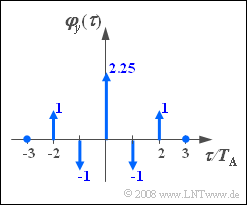Exercise 5.6: Filter Dimensioning
From LNTwww
A discrete-time random variable ⟨yν⟩ with the outlined auto-correlation function (ACF) is to be generated using a digital filter.
Let the discrete-time Gaussian input values xν be characterized in each case by
- the mean value mx=0,
- the standard deviation σx=1.
Notes:
- The exercise belongs to the chapter Creation of Predefined ACF Properties.
- Reference is also made to the chapter Auto-Correlation Function.
- Let all ACF values φy(k⋅TA) with index |k|>2 be zero.
Questions
Solution
(1) Solutions 3 and 5 are correct:
- A recursive filter would always cause an infinitely extended impulse response h(t) and thus also an infinitely extended auto-correlation function (ACF).
- Therefore, a non-recursive filter structure must be chosen here. The specified ACF requires the order M=2.
- Since the input values are Gaussian distributed and mean-free, this also applies to the output values.
- When filtering stochastic signals, the following always applies: Gaussian remains Gaussian and non-Gaussian never becomes (exactly) Gaussian.
(2) The system of equations is:
- k=2:a0⋅a2=1.
- k=1:a0⋅a1+a1⋅a2=−1⇒√u⋅w=−1⇒u⋅w=1.
- k=0:a20+a21+a22=2.25⇒u+w=2.25+2a0⋅a2=4.25.
The two equations with respect to u and w has two solutions:
- u=4, w=0.25: Because of the condition a2=1/a0 (see first equation), a0 and a2 have the same sign.
- Moreover, at least one of the two coefficients is greater than/equal to 1.
- Thus the condition a0+a2=√w=0.5 cannot be fulfilled.
- Therefore, the correct solution is u=0.25_, w=4_.
(3) The result of (2) means that a1=±√0.25=±0.5.
- The positive value leads to the equations
- (1)0.5⋅(a0+a2)=−1⇒a0+a2=−2,
- (2)a0⋅a2=1.
- From this follows a0=a2=−1. With a1=0.5, the final result is:
- a1/a0=−0.5_,a2/a0=1_.
- The solution a1=−0.5 leads to a0=a2=+1 and thus to the same quotients.
(4) In general, this problem has I=4 equivalent solutions (mirroring/shifting as well as the multiplication by −1 in each case).
- Since here the impulse response is symmetrical, there are however only I=2_ different solutions:
- Solution 1: a0=+1,a1=−0.5,a2=+1;
- Solution 2: a0=−1,a1=+0.5,a2=−1.
